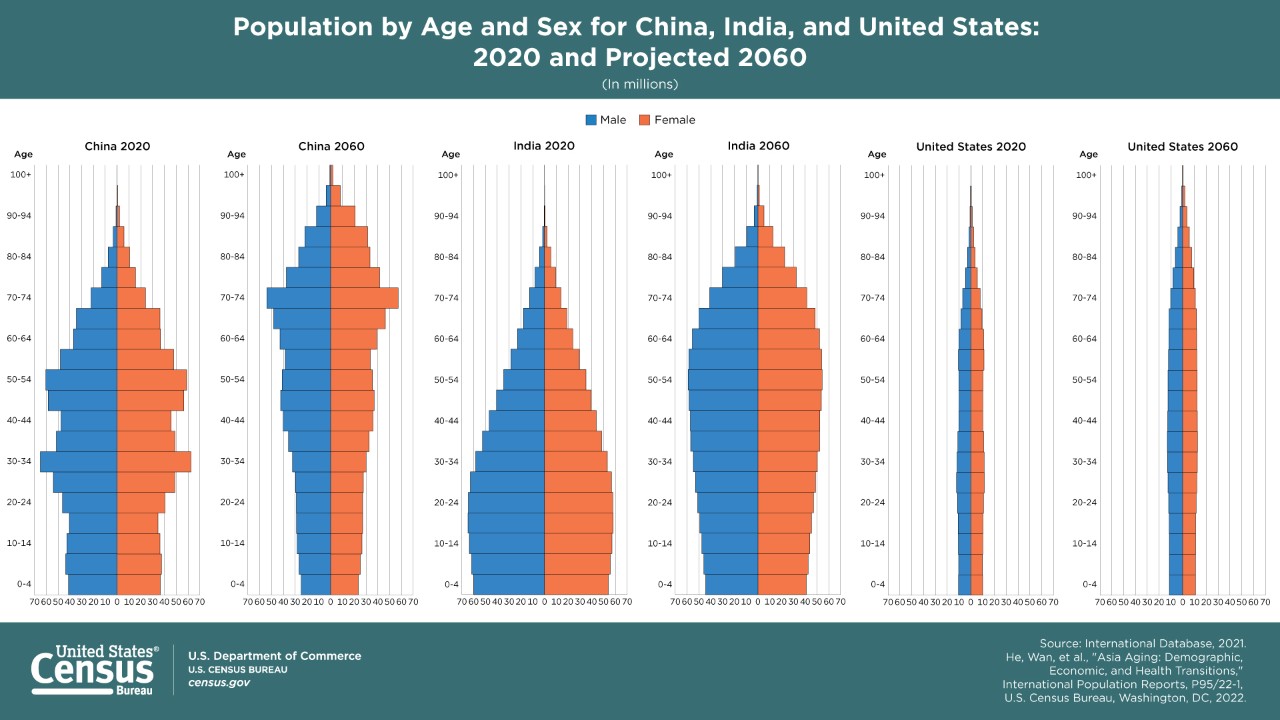For Immediate Release: Tuesday, June 21, 2022
Census Bureau Releases New Report on Aging in Asia
JUNE 21, 2022 — A new report released today by the U.S. Census Bureau shows Asia’s population is aging faster than any other world region. The report also examines aging trends in Asia compared to other world regions and within Asia.
The report, “Asia Aging: Demographic, Economic, and Health Transitions,” produced by the Census Bureau’s International Programs Center in the Population Division, addresses the demographic, economic and health transitions that have taken place in Asian countries, while considering the wide diversity of economic development throughout Asia.
Asia’s aging population is a reflection of the unusually rapid declines in its fertility and mortality rates. Such declines have been associated with rising prosperity in many countries. However, this demographic transition has also led to increasing proportions of the population at older ages.
Just as significant as these dynamics, are the sheer numbers involved. As of 2020, the population of Asia exceeded 4.5 billion (including China and India, the two countries with over 1 billion each), more than one-half the world’s total. There were an estimated 414 million Asian people age 65 and older, about 20% higher than the total U.S. population (331.4 million). Even more noteworthy, it’s projected that by 2060, there will be more than 1.2 billion Asian people age 65 and older, which implies that one out of every 10 people in the world will be an older Asian.
Highlights include:
- The number of older Asian people is expected to nearly triple over the next four decades. A majority of the older population in Asia will be residing in the Eastern subregion (491 million), where China is located, and the Southern subregion (464 million), where India is located.
- Among Asian subregions, 33.7% of Eastern Asia’s population is projected to be age 65 and older by 2060. In contrast, Southern Asia (18.6%) and Western Asia (17.9%) are expected to have the lowest proportions of older people of their regional total populations.
- Asia’s aging has been driven by its unusually rapid demographic transition from higher to lower birth and death rates. Sustained low fertility implies fewer children today and fewer mothers tomorrow, which, along with low birth rates, will cause birth cohorts to shrink.
- Lower mortality results in more people living to older ages, especially women. The female advantage in life expectancy at birth in Asia currently averaged 5.0 years (77.3 years for females vs. 72.3 years for males), although that advantage varied widely across countries.
- Median age in Eastern Asia is projected to rise well past the typical childbearing ages, from 39.4 in 2020 to 51.3 by 2060, reaching 50.0 for males and 52.9 for females. The latter statistic is particularly noteworthy because more than one-half of females are expected to be beyond typical childbearing ages.
- The old-age dependency ratio in Asia in 2020 was 13.5 older people for every 100 at working ages, which roughly translates into six working-age adults supporting one older person. This ratio was comparable to that of Latin America and much lower than those of Europe and North America. There was great variation in these old-age dependency ratios across Asian subregions—from 19.7 (per 100) in Eastern Asia to 8.7 (per 100) in Western Asia.
Other highlights regarding the shifting sources of economic support and the epidemiological transition in Asia:
- Labor force participation differed considerably by region, among countries within regions, between men and women, and across older age groups. The lowest labor force participation rates for women were in Western Asia and Southern Asia.
- As societies develop, the main source of income for older people in Asia (aside from their own earnings) tended to shift from their children to other sources of support such as social insurance programs.
- Although social security pension systems exist throughout Asia, their coverage, benefits and statutory ages varied widely based on each country’s age structure, income level and regulatory environment.
- An epidemiological transition occurred in Asia, whereby, as in other world regions, the composition of morbidity and mortality has shifted from communicable diseases to noncommunicable diseases.
- Certain diseases and pandemics, such as COVID-19, heightened health risks for older Asian people and posed major challenges to health care systems.
- Some Asian countries showed positive shifts in risk factor behaviors but increases in conditions like diabetes and dementia may lead to rising disability levels.
This report uses the United Nations definitions of world regions and subregions: UNSD — Methodology. World regions defined by the International Labour Organization and the World Health Organization are different from the UN geographic regions and are specified in this report. Country or place names used in this report and boundaries depicted in the maps reflect U.S. government policy wherever possible: Independent States in the World - United States Department of State. The majority of demographic estimates and projections data come from the International Database (census.gov) which is maintained and updated by the Census Bureau’s Population Division and is current as of December 2021.
Research for and production of this report were partly supported by the Division of Behavioral and Social Research, National Institute on Aging (NIA).
No news release associated with this report. Tip sheet only.
###








